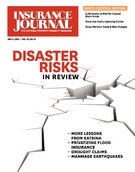The flood plain manager for the Rapides Area Planning Commission in Louisiana said people whose homes flooded may find that repairs bring them under newer and stricter building standards.
Melissa Becker told The Town Talk in Alexandria, La., that the flooding from the Red River in June tracked the area’s flood plain maps pretty well.
She said an ordinance passed in 2007 grandfathered in buildings erected before the current, stricter codes for floodplain development took effect. But if those buildings need major repairs, said Becker, they may have to meet the newer requirements — including minimum elevation standards.
Property in a flood plain must be at or above the level considered to have a 1 percent chance of flooding in any given year. That includes living spaces and all electrical, heating, ventilation, plumbing and conditioning equipment.
Red River Flooding
The Red River crosses Louisiana from the northwest corner of the state until it meets with Ouachita River above Baton Rouge. Its waters eventually merge into the Mississippi River.
National Weather Service crest projections for the Red River changed seven times in two weeks as the river rose in June with floodwaters drained from Oklahoma and Texas. The river finally crested at 37.14 feet at Shreveport.
The weather service and U.S. Army Corps of Engineers used 1990 data as reference points even though up-to-date data was available. North Louisiana Congressmen want to know why.
U.S. Senators Bill Cassidy and David Vitter and U.S. Reps. Ralph Abraham and John Fleming penned a strongly-worded letter, dated June 18, to high-ranking Washington officials in the Army, Army Corps of Engineers and National Oceanic and Atmospheric Administration.
“Communities throughout the state rely heavily on timely and accurate information from Army Corps and NWS on how threats from natural disasters will potentially impact life and property,” the letter said. “The constant change in crest predictions presented significant challenges for state and local first responders.”
The weather service bases river forecasts calibrated from historical data. They account for rainfall, both forecast and observed, soil conditions and other elements, hydrologists said.
Jeff Graschel, a weather service hydrologist, said one problem with the weather service’s models was that stage levels around 34 to 37 feet hadn’t been seen since the 1940s.
“The channel’s changed since then,” Graschel said.
“We had to start making adjustments and increase our forecast for the Shreveport area,” Graschel said. “Because of the channel changes and stuff, we were a little bit into unknown territories as to exactly what the peak flows would be at Shreveport.”
He said hydrologists now have a better understanding of the discharge levels up to 37 feet, though anything higher would remain problematic.
They’ve also learned Red River at Shreveport has less capacity to hold water flowing through it than it used to have, he said.
Was this article valuable?
Here are more articles you may enjoy.


 Hartford Q1 Income Up 41% on Commercial Lines as Auto Results Improve
Hartford Q1 Income Up 41% on Commercial Lines as Auto Results Improve  ‘Buffett Got it Wrong’ on California Fire Risk: PG&E CEO
‘Buffett Got it Wrong’ on California Fire Risk: PG&E CEO  Insurers Get Green Light to Pay Less Than Billed Charges in Florida PIP Cases
Insurers Get Green Light to Pay Less Than Billed Charges in Florida PIP Cases  4,800 Claims Handled by Unlicensed Adjusters in Florida After Irma, Lawsuit Says
4,800 Claims Handled by Unlicensed Adjusters in Florida After Irma, Lawsuit Says 


